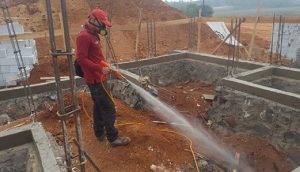Anti Termite Treatment: its 2 Types, Chemicals, & Advantages
The anti-termite treatment is a chemical process to provide the building with a chemical barrier against the underground termites before and after construction work.
This process accomplishes for masonry, wood, soil, and electrical fixtures to provide the building with a chemical barrier against the underground termites.

In the early stages of building construction, soil treatment is applied to a building with the help of anti-termite treatment and it provides the building with a chemical barrier against the underground termites.
Types of Anti Termite Treatment:
There are two main types of anti-termite treatment as given below;
- Pre-Construction Anti Termite Treatment
- Post Construction Anti Termite Treatment
Pre-Construction Anti Termite Treatment:
The process for pre-construction anti-termite treatment is given below;
- The sides and the bottom surface of the foundation trenches and pits are treated with an anti-termite chemical at the rate of 5 Lit per square meter of surface area to a height of about 30cm for the excavation made for the foundation.
- The earth’s surface is firstly cleaned from wooden and any other garbage particles for flooring and to the required elevation, the entire surface should be levelled.
- At an interval of 15 cm holes of 30 cm in depth are made and by adding water to the chemical an emulsion of the correct concentration shall be made.
- By pouring jars, this emulsion shall be poured in the holes and by using pressure pumps and sprayers, sprayed on the surface.
- Through the holes, the chemical is allowed to get soaked fully.

Benefits of Pre-Construction Anti Termite Treatment:
There are the following benefits of this treatment as given below;
- As compared to post-construction treatment, the steps involved in pre-construction treatment are lesser and also have less cost.
- In the case of pre-construction anti-termite treatment, the number of obstacles is lesser.
- Pre-construction treatment is recommended to remove the termite infestation from its root.
Post Construction Anti Termite Treatment:
After the completion of the construction of the building, this treatment is conducted and normally consists of reusing termiticides in the soil around the foundation.
For termite control, it also treats the floors of rooms by making holes under floors and filling them with chemicals. To existing buildings which are already attacked by termites, this treatment is applied.

The soil around and beneath the building is treated with chemical emulsion in case of a severe attack.
With oil or kerosene-based chemical emulsion, the woodwork which is badly damaged by termites may be replaced by new timber brushed in this treatment.
Anti-Termite Chemicals:
For anti-termite treatment in buildings the chemicals used are;
- Chlorpyrifos 20% EC
- Lindane 20% EC
- Imidacloprid 30.5% SC

For the treatment of soil in order to protect a building from termite attack, the above-mentioned chemicals are used in water emulsion and oil or kerosene-based solution of these chemicals with 1.0 % concentration is used for the treatment of wood.
Preventive Measures:
There are the following preventive measures such as;
- Through the cracks or voids, the termites seek their way inside the building floor at some locations such as at the junction of the floor and walls which results in shrinkage, due to construction defects cracks formed on the floor surface and in a concrete floor at construction joints and expansion joints.
- The soil in contact with the external wall of the building shall be treated with the chemical emulsion at the rate of 7.5 lit/Sqm and to a depth of 300 mm to treat the soil outside of foundations.
- In the building area of the ground floor wherever the cracks are noticed chemical treatment should be done and by drilling vertically 12 mm holes at the junction of floor and walls, construction and expansion joints this treatment can be done.
- In the building, all the locations where the woodwork is done must be treated with anti-termite treatment.
- By removing the outer coverings and treating the internal parts with 5 per cent Malathion dusting powder treatment of electrical fixtures can be done.
Advantages of Anti-Termite Treatment:
There are the following advantages of this treatment such as;
- From termites, rodents, and pests it provides immediate protection to any structure.
- For several years it can last.
- This treatment eliminates the problem of gaps forming in the protective barrier.
- As compared to other forms of termite control liquid termiticides are relatively inexpensive.
Disadvantages of Anti Termite Treatment:
There are also some disadvantages of this treatment such as;
- In areas close to waterways or wetlands anti-termite treatment can lead to water contamination.
- It can reduce the strength of the member or structure by drilling into areas that show evidence of termite entry.
- With an infestation in the future, any small negligence or left-out portion can lead to problems.
